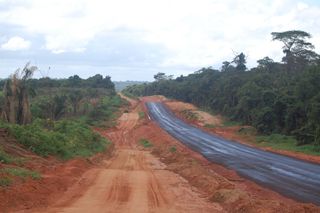More Than 30,000 Miles of Roads Built in Amazon in 3 Years

How long does it take to build a little more than 30,000 miles (50,000 kilometers) of new roads through the rain forest? A new study finds that, in the Brazilian Amazon, such development can happen in just three years.
While roads cover only a tiny fraction of the total land surface of South America's largest nation, their effect on local ecosystems — particularly rain forests — may be huge. In an attempt to better understand road-building's effect on the Amazon, researchers from Imperial College London used road maps and satellite images to track the recent development of the Amazon road network.
The team's report, which was published this month in the journal Regional Environmental Change, concluded that approximately 10,000 miles (17,000 km) of roads were built every year in Brazil between 2004 and 2007. Not surprisingly, road networks were found to spread the most quickly in newly settled areas, as well as in areas experiencing renewed economic growth.
This rampant road-building may be a major contributor to deforestation and habitat loss in one of planet Earth's most biologically diverse regions. But by mapping road construction, researchers think they can aid future efforts to stop destruction of the Brazilian rain forest.
"Knowing where the roads are and the speed at which they are built is key to predicting deforestation," Rob Ewers, Imperial College London scientist and co-author of the study, said in a statement. "An understanding of road networks is the big missing gap in our ability to predict the future of this region."
The effects that roads have on local ecosystems extend far beyond the locations of the roads themselves. This includes changes in the temperature and humidity of air and soil and the movement of animals.
Past research suggests that certain configurations of road networks in the Amazon are more sustainable than others. A 2011 study, funded by the National Science Foundation, found that a "fishbone" configuration, for example, offers a solution that merges development with forest livelihood. Such a network allows roads to be built far enough away from one another that animals and connected ecosystems can continue to thrive despite the intrusion of human infrastructure.
Sign up for the Live Science daily newsletter now
Get the world’s most fascinating discoveries delivered straight to your inbox.
But road construction is just one of many factors leading to the continued deforestation of the world's largest rain forest. Forest fires alone destroyed more than 33,000 square miles (85,500 square km) of forest between 1999 and 2010, according to a recent NASA release. That's an area larger than the state of South Carolina.
And a recent report from the Intergovernmental Panel on Climate Change found that forest fires in the Amazon are only going to get worse, as the region's annual dry season — also known as fire season — continues to extend every year.
Logging and farming also contribute to the continued destruction of the Amazon, with one expert attributing up to 90 percent of all cleared land in the region to the expansion of Brazil's cattle ranching industry.
Follow Elizabeth Palermo on Twitter @techEpalermo, Facebook or Google+. Follow us @livescience, Facebook & Google+. Original article on LiveScience.

Elizabeth is a former Live Science associate editor and current director of audience development at the Chamber of Commerce. She graduated with a bachelor of arts degree from George Washington University. Elizabeth has traveled throughout the Americas, studying political systems and indigenous cultures and teaching English to students of all ages.